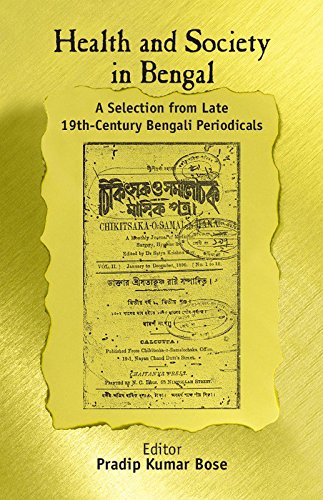
One of the many ways in which imperial powers established and constituted colonial politics was by constructing the relationship between colonialists and the colonial subject in simplistic yet deliberate dichotomies of oriental/occidental, civilised/uncivilised and progressive/regressive. These categories were used to establish the difference between the ‘civilised’ and ‘uncivilised’ peoples — using which the British intended to ‘bring’ civilisation, a progressive science and rational thought to affirm their ideological hegemony over indigenous knowledge systems and practices. This entanglement of power, violence and the production of knowledge, formally known as epistemological violence, underpins much of Bose’s book, Health and Society in Bengal: A Selection From Late 19th Century Bengali Periodicals (published by Sage Publications in 2006).
For Bose, however, the transplantation of Western socio-scientific and biomedical practices in local societies is not as simple as it seems. In this text, he counters the dominant idea that Western scientific methodologies and pedagogies have remained pristine and instead argues that the re-situation of these practices in a different culture led to their re-articulation and reformulation wherein Western scientific concepts lost some of their fixity.
Through the exegesis of one of nineteenth-century Bengal’s primary modes of knowledge dissemination — periodicals — Bose highlights how periodical literature contributed to the friction between Western science and local knowledge: while some attempted to incorporate local modes of knowing with Western socio-scientific thought, others attempted to reject local knowledge as ‘blind’ and ‘irrational’. According to Bose, periodicals acted as mediators between Western and indigenous sciences and facilitated the progress and practice of scientific knowledge at a time when knowledge-practice had not yet been transferred to laboratories. In translating sciences, editors of these periodicals encountered unique problems of language, translation and abridgement that Bose emphasises in great detail throughout the text. He discusses how English became the linguistic medium for Bengali people to discuss, teach and practice medicine and even in present times, there has not been any significant effort to or progress in practising science through Bangla.
The first chapter of the book deals with indigenous medicine and medical science wherein Bose attempts to investigate claims that frame local medical practices and knowledge as unscientific through an assemblage of periodicals that explore Ayurvedic and Unani practices. While expounding on the major debates between practitioners of indigenous knowledge and Western science, Bose draws the reader’s attention to the conceptualisation of the ‘body’ in Ayurveda and Western sciences and inspects the necessity of proving Ayurveda as a science and establishing local medical sciences as functional medical practices.
In discussing the nature, character and concept of National Health in the nineteenth century, the second chapter examines how the Indian, especially the Bengali body was popularly characterised as weak, frail with short lifespans. Bose unpacks the primary arguments in this discourse and identifies a range of reasons for the alleged physical weakness of the Bengali which include the likes of ingestion of European medicines, child marriage, polygamy, masturbation and patronising sex workers. This section makes it apparent that the question of National Health in nineteenth-century India was closely related to religious, social, moral and political discourses.
Chapter three ties conjugal life and sexuality to National Health. In the reading of sex-related medical literature in Bangla, the author notes how sexuality was constructed solely based on utility wherein reproduction was the aim of the sexual congress of husband and wife and did not involve pleasure. Instead, sexual indulgence was seen as an aberration which numbs the body and mind and was detrimental to health. Bose reports that influenced by the eighteenth-century European concept of ‘population’ as a strategy of power, sexual relations and habits became subjects of imperial control.
As the relationship between the State and body grew more complex, medical science assumed new dimensions. According to the author, the question of Public Health became crucial to the colonial state in maintaining economic and political control of the country. Focusing on the British and their interventions to control communicable diseases and epidemics such as smallpox, Bose’s collection of periodicals in chapter four outlines the role of periodical literature in disseminating health education among the masses.
Ultimately, Bose’s efforts to illustrate the relationship between power and knowledge raise interesting questions vis-à-vis institutions of knowledge, their organisation, distribution, structure, methods, scope and the histories of scientific knowledge. Instead of treating nineteenth-century Bengal as a monolith, Bose’s treatment of history and society contributes to a more nuanced comprehension of the time. The book offers an understanding of the history of indigenous scientific and biomedical knowledge systems and knowledge practices of Bengal. Although Bose does not address how different marginalisations shaped the relationship between the body and the State what distinguishes him as a scholar is his recognition of the episteme as a specific site of colonial violence and critical appraisal of different ways in which Western and indigenous knowledge influenced and complemented each other in colonial Bengal and continue to do so.
***
Sara Bardhan is a student of Urban Policy and Governance at the School of Habitat Studies, Tata Institute of Social Sciences (TISS), Mumbai. Her wide-ranging research interests center around urbanisation, urban health and sanitation, feminist urbanisms, and urban futures, fantasies and pleasures in contemporary South Asia.